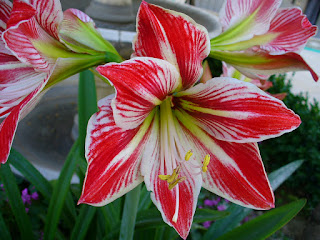 |
| I usually see juncos in flocks |
A chickadee hopped along the oak trunk, jumping between the protective horizontal shoots of a climbing hydrangea. Meanwhile a cardinal couple appeared and disappeared among the dense evergreen needles of a large nearby yew.
 |
| This husky hydrangea vine provides cover for birds even after its leaves drop |
A week later at twilight, my attention was drawn to a loud chirping from the newel post of the front steps railing. I was able to identify the small bird that perched there, vocalizing officiously, as a house wren, Troglodytes aedon.
 |
| House wren - photo JanetandPhil |
This is not a rare species, but it’s not one I’ve seen in my yard before. I was proud to read on the Audubon Bird Guide app that this bird feeds on insects and likes to forage on the ground where there’s dense low growth—like here!
The house wren reportedly has a distinctive bubbling song. What I heard instead was its “excited chit call.” Listening to a recording on the app confirmed my bird identification. House wrens spend the breeding season all over North America, from southern Canada to the Mexican border. My wren may have been on the way to winter grounds in the southern US or Central America, migrating by night. How a five-inch bird weighing a few ounces can accomplish this long journey remains a wonder to me (For more on birds’ amazing powers, don’t miss The Genius of Birds, by Jennifer Ackerman).
All these bird sightings seem to vindicate this year’s plan of piling up fall leaves on my garden beds. The reason for doing this instead of sending them out as yard waste or shredding them for mulch was to provide shelter for insects through the winter. When I see birds busily foraging in the yard, I can believe that leaf litter is doing its job.
 |
| Insects weather the winter among the fallen leaves--unless predators find them |
It turns out that those chickadees I see on the oak trunk are champions at coping with the cold. They can’t put on a lot of extra fat or a down layer like larger birds, because that would mess with their aerodynamics. Many small birds adapt by fluffing up their feathers, huddling together, and shivering in a special way by activating opposing muscle groups. Chickadees go further, dropping their nighttime body temperature by as much as 22° Fahrenheit in what’s called regulated hypothermia.
 |
| Chickadees are ready for the cold - photo USFWSmidwest |
How can we not want to help these birds with some winter calories to keep them warm? I’ve stopped filling my bird feeders during the warmer months, but now they’re back in action, and birds are using them. It’s encouraging to see them also hunting insects in those piles of fall leaves. This is the balance I’m aiming to achieve.
 |
| Coming soon |
I'm off to visit the kids. See you in the New Year!















































